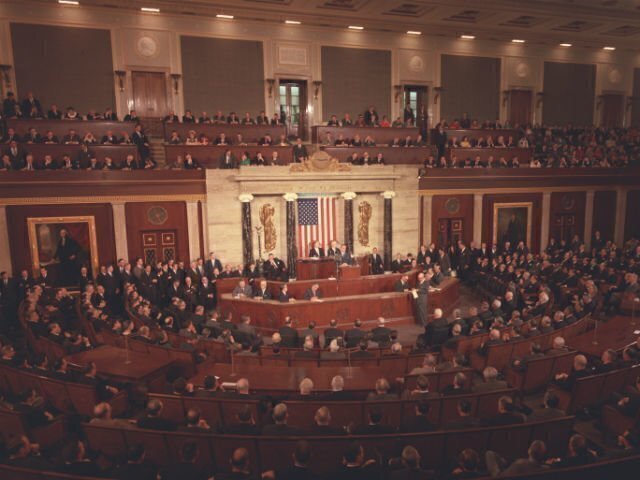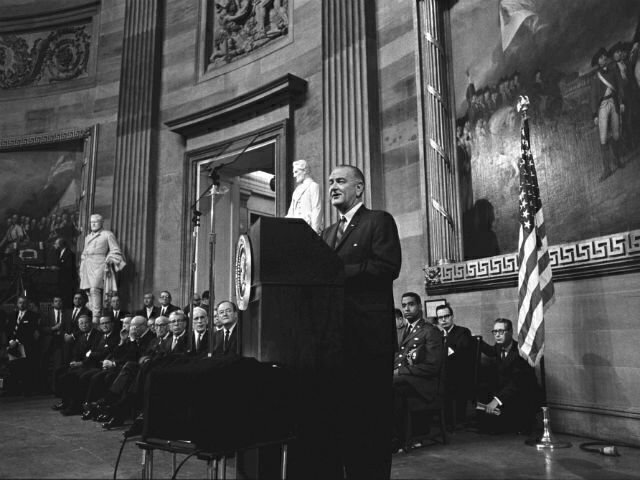This commentary is part of a blog symposium honoring the 50th anniversary of the Voting Rights Act. Other contributions come from Roger Clegg, Rick Hasen, Kermit Roosevelt, J. Christian Adams, Brianne Gorod and Nathaniel Persily.

Fifty years ago this week, President Lyndon Baines Johnson signed the Voting Rights Act. He then stood up, turned around, and shook the hand of the Rev. Martin Luther King, Jr. That majestic tableau captured the potent links among civil rights protest, King’s indomitable courage, and LBJ’s iron will. These two men seized that era’s opportunities to reconstruct American democracy. They rewrote the rules for voting and elections in the ex-Confederacy. They and the other guests in the room also represented the literally countless men and women who prepared the table for the day’s great change, some by giving their lives.
The Voting Rights Act enforces the 15th Amendment provision that the “right of citizens of the United States to vote shall not be denied or abridged by the United States or by any State on account of race, color, or previous condition of servitude.” In doing that, the Act has acquired semi-constitutional status. The Act has been on the books for roughly one-fifth of the time that the Constitution has been in existence. Four Congresses and Presidents have renewed and strengthened its temporary provisions—in 1970, 1975, 1982, and 2006—and they also added new and permanent protections. Not very long ago, it was possible to think of the Voting Rights Act as something like a “super statute”—a statute that is deeply woven into the nation’s political fabric and commands the kind of general respect that the Constitution enjoys.
But kryptonite that weakened the Act came from the Supreme Court in June 2013 in its momentous 5-4 decision, Shelby County v. Holder. The Court corrected—and thereby impaired—the Voting Rights Act Reauthorization Act of 2006. In a briskly written opinion, Chief Justice John Roberts held that Congress unconstitutionally failed during its 2006 renewal to update the “coverage” section of the statute. This was Section 4; at the time of Shelby, this part of the Act defined the jurisdictions that receive special federal scrutiny through an administrative process known as “preclearance.” The Chief Justice emphasized that Congress did not recognize the enormous success of the Voting Rights Act in the covered states. Instead, Congress renewed Section 4 on the same terms that it had used at the last renewal in 1982. The criteria for coverage rested in part on turnout data for the presidential elections of 1964, 1968, and 1972. These were obsolete data. Such coverage indicators no longer described the reality of voting rights in the ex-Confederacy.
Section 4 thus created truly intrusive federal regulation. What was unconstitutional about it was its naked violation of the principle that the states are, in principle, equal and “sovereign.” They are entitled to the presumption that they are free from federal supervision with respect to a core prerogative, such as the making of election law, unless there is compelling reason to nationally supervise some of them and to distinguish some states from others. That reason no longer existed.
Shelby’s reworking of the 2006 renewal also went beyond the Section 4 holding. The section of the Act that establishes so-called “preclearance,” Section 5, can only function if there is a coverage section. Section 5 required covered jurisdictions to forward their proposals for changes in election law to Washington, DC for “preclearance.” That is, they could implement new election law only if the federal government did not object to it (specifically, either the Civil Rights Division of the Department of Justice or the U.S. District Court for the District of Columbia). Lack of objection signified “preclerarance.” Although actual objection happened rarely (as measured by the percentage of total submissions that triggered preclearance), the preclearance process impeded discriminatory changes in election law.
Shelby said nothing about the constitutionality of Section 5 but the invalidation of Section 4 simultaneously shut down Section 5. State and local officials now no longer need to worry about preclearance when they consider such matters (among others) as changes in the rules for voter eligibility and for balloting, the locations of polls, the lines of electoral districts, and changes in the boundaries of a jurisdiction through annexation of adjacent jurisdictions or deannexation of portions of existing jurisdictions. They can face litigation under Section 2 of the statute, which forbids racial discrimination in election law. But such litigation is time-consuming and uncertain for those who initiate it.
In the two years of debate since Shelby, many have argued in good faith that Shelby appropriately turned a page that needed to be turned. American democracy has been permanently improved for the better. But others are quite worried. Increasingly they see the Shelby decision as the opening for an effort to roll back the gains of the voting rights revolution. They point, for example, to restrictive changes in voting procedures in two key states that were previously covered wholly or in part by Section 4 of the Act, Texas and North Carolina.
To be sure, there is considerable debate among number crunchers about the actual impact of such laws. Also, public opinion polls find surprisingly broad support for the idea of “fraud-proofing” the vote. As for figuring out the motivation behind these laws, one major study shows that these laws do seem to have racial animus behind them, another shows that partisan strategy instead stands behind these laws, and a third elegantly argues that “race” and “party” are inevitably intertwined.

Despite the uncertainty and debate among scholars, civil rights leaders and lawyers clearly think that such laws are meant to harm the civic standing of African-Americans. The changes in North Carolina have prompted sustained protest—and a major challenge by the Justice Department under permanent provisions of the Voting Rights Act. The first phase of that legal challenge concluded last week in Winston-Salem at the federal district court for the Middle District of North Carolina.
This anniversary of the Voting Rights Act differs, then, from the last significant anniversary, the 40th anniversary, which featured high hopes for the Act’s long life and continued influence. Today’s remembrance is more troubled, more divided. And there is little hope, for the moment, that the two political parties will address the Supreme Court’s decision.
Indeed, for those who know their American political history, the uneasy nature of today’s anniversary underscores a basic fact about the struggle for African-American voting rights: as a country, we have simply never had completely normal, taken-for-granted voting for the vast majority of African-Americans. There has always been, somewhere in the U.S. and for large numbers of African-American citizens, a question mark over their voting—sometimes huge and very prominent, high up in the sky, other times much faded and smaller, but still there.
The quest for a “no-question-mark” kind of voting experience for all African-Americans seems literally never-ending. It started before the Civil War in Northern states, when free African-American adult males fought legislative efforts to push them out of the electorate.
Then came Reconstruction—and it seemed to promise a new kind of democracy. Indeed, Reconstruction made America unique in world history. It swiftly conveyed men and women who had composed the world’s largest system of slavery into citizenship, and the men into active voters. Three constitutional amendments and a panoply of statutes protected them. Nearly 650 state legislators and a vast corps of local officeholders were black Southerners. Black men served in Congress. No other post-emancipation society anywhere had a similar outcome.
But gradually, over several decades, black Southerners were pushed out of the electorate and from public office. By the early 20th century, there were serious calls to repeal the 15th Amendment and thus to formalize black disenfranchisement. Amidst these dark times the NAACP began to form—and to plan the great march back toward a Constitution that actually worked the way it read. It took most of the 20th century to rebuild political democracy in the South. Not until this new century did the voting rates of white and black Southerners converge.
So, viewed in long-run historical perspective, perhaps the really remarkable thing about this anniversary is that the Voting Rights Act’s unsettled nature—and our tense anniversary—are echoes of a long, long history. They recapitulate our nation’s unending, often epic struggle for the full political incorporation of African-Americans and of the other minorities covered by the Voting Rights Act.
Yet we can also remind ourselves of the dignity of democracy—the fact that it requires hard thinking and effort from all of us. Democracy is a work in progress, sometimes a long work in progress. Today we may feel a bit unsettled, but we also honor that great truth.
Rick Valelly teaches American politics at Swarthmore College and is author of the prize-winning book, The Two Reconstructions: The Struggle for Black Enfranchisement (University of Chicago Press, 2004).
Editor’s note: Commentaries appearing on Constitution Daily reflect the opinions of their authors, and not those of the National Constitution Center.
Recent Stories on Constitution Daily
Voting Rights Act gets partial win on eve of 50th anniversary
Constitution Check: Who has the job of picking the candidates for the presidency?







